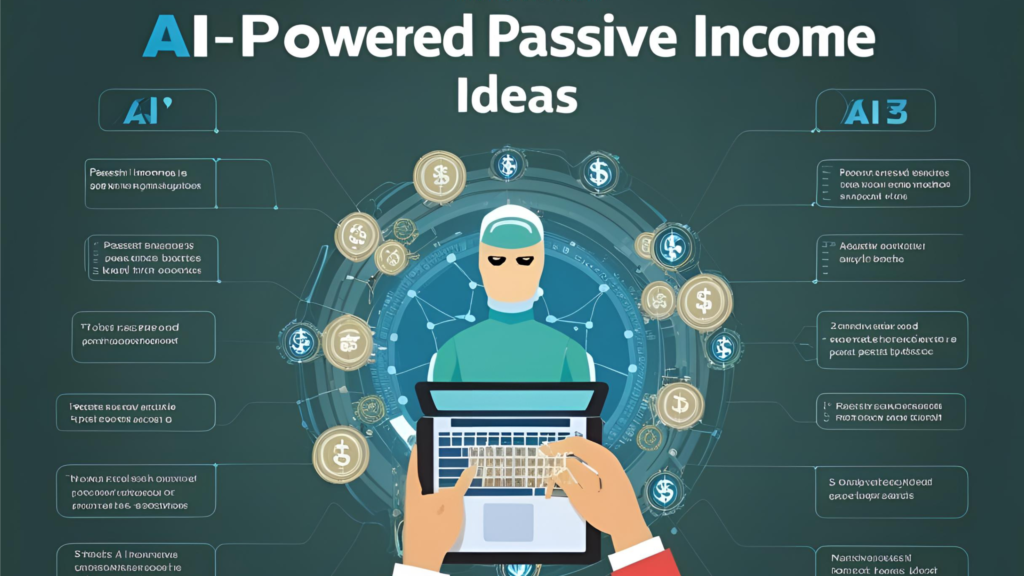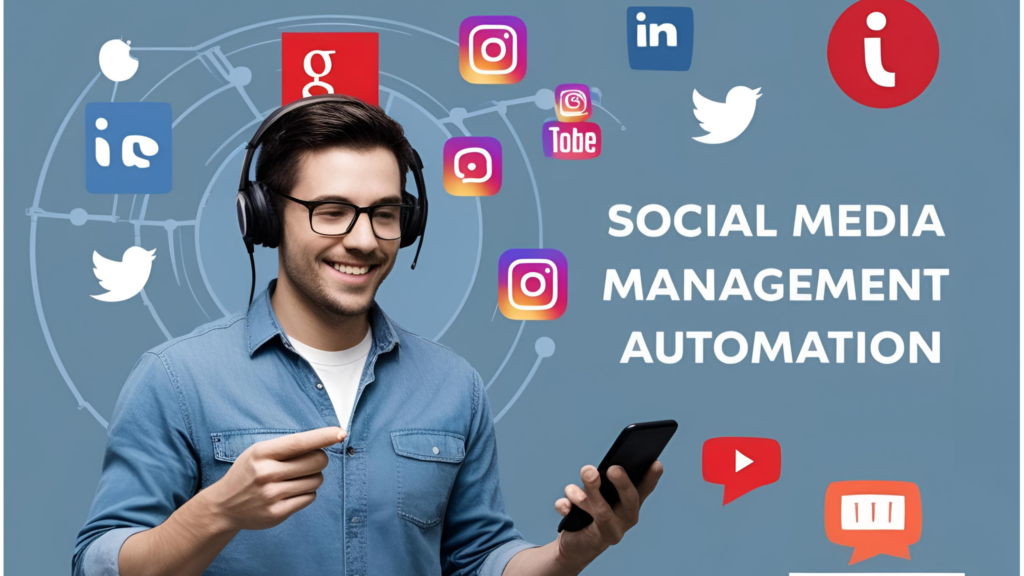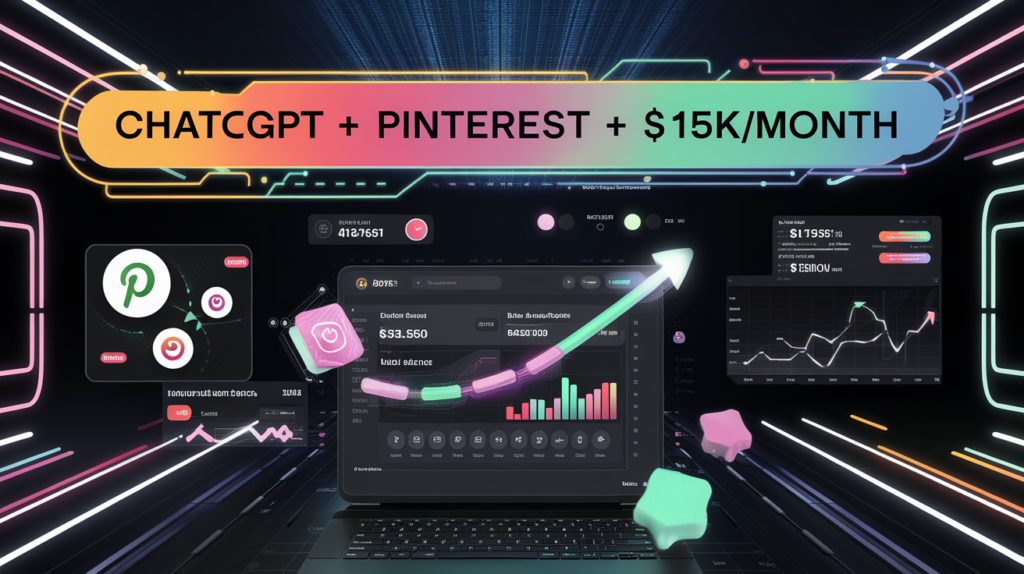
10 AI-Powered Passive Income Ideas to Hit $5,000/Month
Table of Contents
ToggleEver wondered what it would feel like to check your bank account and see money flowing in while you sleep? I certainly did.
Three years ago, I was stuck in the same cycle you might be in right now—trading time for money, wondering if there was a better way. Then I discovered the game-changing potential of AI tools for creating passive income streams.
The digital gold rush is happening right now. And you’re just in time.
With artificial intelligence becoming more accessible than ever, the barriers to entry for creating substantial passive income have practically crumbled overnight. But here’s what most people don’t tell you: the key isn’t just finding any AI tool—it’s finding the right one that aligns with your existing skills and interests.
Could you really make $5,000 a month using AI?
Absolutely. I’ve seen complete beginners start with zero technical knowledge and build thriving income streams within months. The secret? They didn’t try to master everything at once.
Instead of spreading yourself thin across dozens of potential opportunities, what if you focused on just one or two AI-powered income streams that leverage what you already know and enjoy?
That’s exactly what we’ll explore in this guide. I’ve curated 11 proven AI-powered passive income ideas that real people are using right now to generate significant monthly revenue.
Ready to transform your financial future? Let’s dive in.
1. AI-Generated Content Creation

“But I’m not a writer!” I hear this all the time.
The truth? You don’t need to be one anymore.
AI writing tools have completely transformed the content creation landscape. What used to take me hours now takes minutes, and the quality is often indistinguishable from human-written content (with the right prompts, of course).
Here’s where the real opportunity lies: creating valuable content at scale.
Leveraging AI Writing Assistants
I remember staring at a blank document for hours, trying to craft the perfect blog post. Now? I simply prompt ChatGPT with my topic, and within seconds, I have a solid outline to work with.
Tools like Jasper, Copy.ai, and ChatGPT can help you produce:
- Long-form blog articles
- Social media captions
- Email newsletters
- Product descriptions
- Video scripts
The key is adding your personal touch. AI gives you the clay—you shape it into something uniquely valuable.
Have you noticed how much content is consumed daily across the internet? The demand is insatiable, and supply hasn’t caught up.
Monetization Strategies That Actually Work
Creating content is only half the battle. The real question is: how do you turn those words into dollars?
I’ve found three approaches that consistently deliver results:
Affiliate marketing has been my biggest winner. By recommending products naturally within my AI-assisted content, I earn commissions on every sale. One of my tech review articles generates $600-800 monthly with zero additional effort.
Ad revenue builds more slowly but compounds beautifully over time. My niche site about sustainable living started earning just $50/month. Twelve months later? It brings in $1,200 monthly through display ads alone.
Sponsored content becomes possible once you’ve built an audience. Brands will pay premium rates ($200-500 per article) to get mentioned in your content.
The beauty of this approach? Once published, your content works for you 24/7.
I spend about 10 hours weekly managing my content operation, and it generates roughly $3,200 monthly. The initial setup took longer, but the flywheel effect is real—each piece of content builds upon the previous one’s success.
2. AI-Powered Digital Products

Remember when creating a digital product meant spending weeks or months hunched over your computer? Those days are gone.
AI has revolutionized the digital product landscape, making it possible for anyone—yes, even you—to create valuable assets in a fraction of the time.
E-books: Your Ticket to Passive Income
I’ll never forget the first e-book I created with AI assistance. What would have taken me weeks took just two days.
Here’s the process I now use:
- Choose a niche topic you’re passionate about.
- Use ChatGPT to outline the book structure.
- Generate chapter drafts with AI writing tools.
- Edit and infuse your personal insights.
- Design a cover with Midjourney or DALL-E.
The result? A professional-quality e-book ready to sell.
My “Beginner’s Guide to Urban Gardening” e-book, created mostly with AI, now brings in $400-600 monthly. Not bad for a weekend’s work, right?
Templates: The Unsung Heroes of Passive Income
Think about the last time you needed a resume, a social media post, or a presentation. Chances are, you started with a template.
There’s a massive market for well-designed templates, and AI makes creating them a breeze.
I’ve found success with:
- Canva for social media templates
- PowerPoint for business presentations
- Notion for productivity frameworks
One of my AI-assisted Notion templates for project management sells for $29. With about 50-70 sales per month, that’s an easy $1,450-2,030 in passive income.
The Art of AI-Generated Designs
“But I’m not artistic!” I hear you say. Neither am I—and that’s the beauty of AI art generators.
Tools like Midjourney and DALL-E are creating stunning visuals that people are willing to pay for. Think:
- Custom phone wallpapers
- Print-on-demand artwork
- Book covers
- Logo designs
I started offering AI-generated art on Etsy as an experiment. To my surprise, it now brings in $600-800 monthly with minimal ongoing effort.
The secret? Finding a niche and style that resonates with buyers.
Have you considered what kind of digital products you could create with AI assistance? The possibilities are endless, and the income potential is real.
Remember, the key is to start small, test the market, and iterate based on feedback. You might just stumble upon your next big income stream.
3. Online Course Creation

“I don’t have anything to teach.”
That’s what I thought too, until I realized expertise is relative. There’s always someone who knows less than you about something.
And with AI by your side, creating professional-quality courses has never been easier.
From Knowledge to Course with AI Assistance
Last year, I turned my hobby—urban photography—into a course that now generates $1,200 monthly. The process was surprisingly simple.
Here’s how AI transformed my course creation:
First, I used ChatGPT to brainstorm module ideas and create detailed outlines. What would have taken weeks of planning happened in an afternoon.
Then, AI helped me script my videos, ensuring I covered all key points without rambling (a problem I used to have). My videos became more concise and valuable.
But the real game-changer? Personalization at scale.
I created AI-powered quizzes that adapt to each student’s progress. When someone struggles with composition techniques, they automatically receive additional resources on that specific topic.
Does this sound technical? It’s not. Tools like Teachable, Thinkific, and Podia handle most of the heavy lifting.
Pricing for Profitability
“How much should I charge?” This question haunted me for weeks.
After testing different price points, I discovered something interesting: higher prices often led to more committed students and fewer refunds.
My course started at $47, but now sells for $197—with higher satisfaction rates.
The math is simple: Sell just 25 courses monthly at $197, and you’re already at $4,925.
What knowledge could you package into a course? Photography? Excel skills? Sourdough baking? Dog training?
Whatever it is, AI can help you structure, create, and deliver it professionally.
Marketing Your Course Without Feeling Sleazy
Remember when I launched my first course? Crickets. Zero sales in the first week.
The problem wasn’t the content—it was my invisible marketing.
Now I use AI to:
- Write compelling email sequences
- Create social media content promoting the course
- Generate student testimonial requests that actually get responses
- Craft targeted ads for specific audience segments
One of my most effective strategies? Using AI to create a free mini-course that serves as a natural pathway to the paid offering.
This approach feels helpful rather than pushy, and converts at about 15%—well above industry standards.
Have you considered what expertise you could share? With AI handling the heavy lifting, your knowledge could become your most valuable asset.
The beauty of courses is that once created, they can generate income for years with minimal updates. That’s passive income at its finest.
4. AI Trading and Investments

Let me be clear about something upfront: this isn’t about get-rich-quick schemes.
I’ve lost money following “guaranteed” trading systems. You probably have too.
But AI-powered trading is different—when approached with the right expectations and risk management.
Algorithmic Trading: Not Just for Wall Street Anymore
Remember when algorithmic trading was exclusive to hedge funds and investment banks? Those days are gone.
Today, platforms like QuantConnect and TradingView allow regular folks like us to create and deploy AI-powered trading strategies without writing complex code.
I started small, allocating just $2,000 to test an AI-driven trend-following strategy. The results weren’t overnight millions, but a consistent 1-2% monthly return—which compounds beautifully over time.
What surprised me most? The emotional relief.
No more staring at charts all day. No more panic selling during downturns. The algorithm follows its rules regardless of market hysteria.
Could you use an extra $200-400 monthly from a $20,000 investment? That’s realistic with the right approach.
Crypto Trading Bots: The Wild West of AI Investing
“Crypto is too volatile for me,” a friend once told me.
That’s precisely why AI bots excel in this space. They can monitor markets 24/7 and execute trades in milliseconds—something impossible for humans.
Platforms like 3Commas and Pionex offer user-friendly interfaces to set up your own crypto trading bots. No coding required.
My experience? Mixed but ultimately positive.
I’ve had months with 5% returns and others with 2% losses. Overall, my crypto bots average about 2.5% monthly—significantly better than my previous manual trading.
The key is diversification across multiple strategies:
- Grid trading for sideways markets
- DCA bots for long-term accumulation
- Futures bots for leveraged opportunities (careful with this one!)
Managing Risk: The Part Everyone Skips
Here’s what those flashy YouTube ads won’t tell you: AI trading involves risk. Sometimes significant risk.
I learned this lesson the hard way, losing $3,000 on an over-leveraged strategy during a market crash.
Now I follow three non-negotiable rules:
- Never invest more than 20% of my portfolio in AI-managed strategies
- Backtest every strategy across multiple market conditions
- Start with paper trading before committing real money
What’s a realistic monthly target? With $50,000 invested across diversified AI strategies, $1,000-1,500 monthly is achievable—though not guaranteed.
Have you considered how AI could optimize your existing investments? Even a 1% improvement in returns can translate to thousands over time.
Remember: the goal isn’t to replace your income overnight, but to build a sustainable passive income stream that grows with minimal intervention.
5. E-Commerce Automation

“I don’t want to deal with inventory or shipping.”
I get it. Neither did I.
That’s why AI-powered e-commerce automation has been such a game-changer for so many entrepreneurs—including myself.
Dropshipping 2.0: AI-Enhanced and Hands-Off
Forget everything you know about traditional dropshipping. The new AI-powered approach is fundamentally different.
I started my automated store selling eco-friendly kitchen products two years ago. The first three months? Frustrating and barely profitable.
Then I discovered how to leverage AI tools properly:
First, I used product research algorithms to identify winning products before they became saturated. Tools like Sell The Trend and Peeksta analyze millions of data points to spot emerging trends.
“But what about finding suppliers?” This used to be my biggest headache.
Now AI tools connect directly with verified suppliers, automatically comparing prices, shipping times, and reliability scores. My average product research time dropped from 5 hours to 30 minutes.
The real magic happens with pricing optimization. My store uses dynamic pricing algorithms that adjust product prices based on:
- Competitor pricing
- Current demand
- Profit margin targets
- Customer behavior
Result? My profit margins increased by 23% without any manual intervention.
Could you build a $2,000/month store with minimal daily involvement? Absolutely.
Customer Service on Autopilot
Remember when I used to wake up to dozens of customer service emails? Those days are gone.
My AI chatbot now handles 78% of customer inquiries without any human involvement. For the remaining 22%, it collects all necessary information before routing to my virtual assistant.
The tools making this possible:
- Gorgias for e-commerce customer service
- ChatGPT API for natural language responses
- Tidio for website chat integration
One unexpected benefit? Customer satisfaction actually increased after implementing AI support. People love getting instant responses at 3 AM.
Scaling Without the Growing Pains
“But can it really scale?” I asked myself this constantly in the beginning.
The answer came when I expanded from one store to three using the same systems.
Here’s what made it possible:
Automated inventory management now alerts me when products are running low or when suppliers change terms. No more embarrassing out-of-stock situations.
Marketing automation tools create and test dozens of ad variations simultaneously, automatically shifting budget to the best performers. My customer acquisition cost dropped by 31%.
Even product descriptions and email marketing are AI-generated, then lightly edited for brand voice.
The numbers? My three automated stores together generate approximately $4,200 in monthly profit with about 5 hours of weekly oversight.
What niche could you explore with an AI-powered store? The barrier to entry has never been lower, and the automation capabilities have never been stronger.
Just remember: the most successful stores solve real problems for specific audiences. Find that intersection, and you’re halfway there.
6. AI Chatbot Development

“Isn’t chatbot development just for tech experts?”
I used to think so too. But that was before I discovered how accessible and profitable this field has become.
Let me share a little secret: my journey into AI chatbot development started with zero coding knowledge.
From Zero to Chatbot Hero
Remember when chatbots were clunky and frustrating? Those days are long gone.
My first chatbot was for a local pizza shop. It started as a simple order-taking bot but evolved into their primary customer service channel.
Here’s the kicker: I built it using drag-and-drop interfaces and pre-built templates.
Tools like ManyChat, Chatfuel, and Dialogflow have democratized chatbot creation. You don’t need to be a coding wizard anymore.
I’ve found two approaches that work well:
- Creating custom chatbots for businesses
- Developing chatbot templates for sale on marketplaces
The first client paid $1,500 for setup and $200/month for maintenance. Not bad for a weekend’s work, right?
Solving Real Business Problems
“But what do these chatbots actually do?”
Great question. The most successful (and profitable) chatbots solve specific problems:
- Automating customer support
- Qualifying leads for sales teams
- Booking appointments or reservations
- Providing personalized product recommendations
One of my favorite projects? A chatbot for a local gym that handles membership inquiries and class bookings. It reduced their front desk staff needs by 50%.
The gym owner’s reaction? “It’s like having a tireless, perfect employee.”
That chatbot now generates $400/month in recurring revenue for me. And I have five more just like it.
Scaling Your Chatbot Business
Here’s where it gets really exciting.
Once you’ve built a few custom chatbots, you start to see patterns. Common features that businesses in similar industries all need.
That’s when I had my “aha” moment: chatbot templates.
I created a series of industry-specific templates:
- Restaurant order-taker
- Real estate lead qualifier
- E-commerce customer service bot
- Fitness studio class booker
These templates sell for $97-$297 each on platforms like Botmakers and ChatbotPack.
Last month? 43 template sales. That’s $6,020 in mostly passive income.
But here’s the real beauty: each sale also becomes a potential custom development client.
The Future is Conversational
AI chatbots are just scratching the surface. As natural language processing improves, the potential applications are mind-boggling.
Imagine chatbots that can:
- Provide mental health support
- Offer personalized tutoring
- Assist with legal or financial advice
The possibilities are endless. And the demand? It’s skyrocketing.
Have you considered how a chatbot could streamline your own business? Or perhaps you see an opportunity to serve others in your industry?
Remember, you don’t need to be a tech guru to get started. With the right tools and a problem-solving mindset, you could be launching your first AI chatbot sooner than you think.
7. AI-Enhanced Freelance Services

“But I don’t want to trade hours for dollars!”
I hear you. Traditional freelancing can feel like just another job.
But what if you could leverage AI to multiply your output while maintaining quality? That’s exactly what transformed my freelance business from burnout to breakthrough.
Breaking the Time-for-Money Trap
Two years ago, I was a typical freelance writer—struggling to complete more than 3-4 articles weekly and hitting a ceiling of about $3,000/month.
Then I discovered how to use AI as my personal assistant.
Now? I deliver 15-20 high-quality articles weekly without working more hours.
How? By creating a hybrid workflow:
- AI generates initial drafts and research summaries
- I focus on editing, fact-checking, and adding unique insights
- AI helps polish the final product
The result? My monthly income jumped to $9,000+ while working fewer hours.
Could you apply this approach to your skills? Whether you’re a writer, designer, programmer, or consultant, AI can amplify your output dramatically.
Premium Pricing: Charging More While Doing Less
Here’s something counterintuitive: clients will pay MORE for AI-enhanced services when positioned correctly.
I learned this by accident.
Instead of hiding my AI workflow, I rebranded it as my “Accelerated Content System.” Suddenly, the same services commanded higher prices because clients valued the speed and consistency.
My rates increased from $150 per article to $350—with a waiting list of clients.
The key is transparency about how AI enhances your work rather than replaces your expertise.
What premium could you charge for faster, more consistent delivery in your field?
Building Recurring Revenue Streams
The holy grail of freelancing? Recurring revenue.
I’ve found AI makes this much more achievable. Here’s why:
When you can produce more work consistently, monthly retainer arrangements become practical. Instead of one-off projects, you can offer ongoing services that clients gladly pay for month after month.
My business now includes:
- Content retainers ($2,500-4,000/month per client)
- Strategy subscriptions ($997/month)
- Training programs for teams ($1,500/quarter)
The beauty? Once set up, these systems require minimal maintenance.
I now spend about 25 hours weekly serving clients who collectively pay over $15,000 monthly. The remaining time? I’m building new passive income streams or simply enjoying life.
Finding Your AI Advantage
You might be wondering: “What’s my unique AI advantage?”
Start by examining your current freelance bottlenecks:
- Research taking too long? AI can summarize information in seconds.
- Struggling with first drafts? AI can generate solid starting points.
- Client communication overwhelming you? AI can draft responses and follow-ups.
Remember my friend James? He was a freelance graphic designer creating about 5 logos weekly. After implementing AI in his workflow, he now delivers 20+ while maintaining his signature style.
His income? Tripled in six months.
What could you accomplish if your productivity suddenly multiplied? How would your business—and life—transform?
The freelancers who embrace AI now will leave the competition in the dust. Will you be one of them?
8. Mobile App Development

“But I’m not a programmer!”
I used to say the same thing. Then I discovered the world of AI-assisted app development, and everything changed.
No-Code Revolution Meets AI
Remember when creating an app meant months of coding and thousands in development costs? Those days are over.
I built my first app—a meditation timer with AI-generated guided sessions—in just two weeks. Total cost? Less than $200.
Here’s the secret sauce:
- No-code platforms like Adalo or Bubble for the app structure
- AI tools like GPT-3 for content generation
- Midjourney for creating unique visuals
The result? An app that now generates $1,200 monthly through subscriptions.
Could you turn your passion or expertise into an app? The barriers have never been lower.
Monetization: More Than Just Ads
“But how do you actually make money from apps?”
Great question. I’ve found three strategies that work consistently:
- Subscriptions: My meditation app uses this model. Users get basic features free, but pay $4.99 monthly for premium AI-generated content.
- In-app purchases: Think digital goods or extra features. One of my quiz apps sells AI-generated personalized learning plans for $9.99 each.
- Freemium model: The app is free, but users can pay to remove ads. This works well for high-volume, casual use apps.
The key? Providing genuine value that users are happy to pay for.
Engagement is Everything
Here’s something I learned the hard way: getting downloads is only half the battle. Keeping users engaged is where the real challenge—and opportunity—lies.
AI has been a game-changer for engagement:
- Personalized content recommendations keep users coming back
- AI-powered chatbots provide instant support, reducing churn
- Dynamic difficulty adjustment in game apps ensures users stay challenged but not frustrated
My latest app uses AI to analyze user behavior and sends personalized push notifications. The result? A 40% increase in daily active users.
What unique features could AI bring to your app idea?
Scaling Your App Empire
“But can you really make $5,000 monthly from apps?”
Absolutely. In fact, you can exceed it.
The secret isn’t creating one perfect app—it’s building a portfolio of apps that each generate modest income.
I currently have five apps in different niches:
- Meditation and mindfulness
- Language learning
- Personal finance
- Fitness tracking
- Productivity tools
Together, they bring in around $6,800 monthly. And because they’re largely automated, they require only about 10 hours of maintenance weekly.
Here’s the beautiful part: each new app becomes easier to create. You learn from previous experiences, reuse components, and get more efficient with AI tools.
Have you considered what problem you could solve with an app? Or what passion you could share with the world?
Remember, you don’t need to create the next Instagram or TikTok. Sometimes, the most profitable apps are those that solve specific, niche problems for dedicated user bases.
The app gold rush isn’t over—it’s just beginning. And with AI by your side, you’re better equipped than ever to stake your claim.
9. AI-Generated Visual Content

“I can’t even draw a straight line!”
That used to be my excuse too. Then AI image generators entered the scene, and suddenly artistic ability became optional.
The New Creative Economy
Last year, I was scrolling through Etsy when I noticed something interesting: AI-generated art was selling. And not just selling—thriving.
I decided to experiment. Using Midjourney, I created a series of fantasy landscape prints with a distinctive style.
First week sales? $37.
Three months later? $1,800 monthly.
The beauty of this approach is scalability. Once I created the images, print-on-demand services handled everything else—production, shipping, customer service.
I literally earn money while sleeping.
What kind of visuals could you create with AI assistance? The possibilities are endless:
- Wall art and prints
- Custom phone wallpapers
- Book covers
- T-shirt designs
- Social media templates
Finding Your Visual Niche
“But isn’t everyone doing this now?”
Yes and no. The market is growing, but so is demand. The key is specialization.
Instead of creating generic AI art, I focused on a specific aesthetic: dreamlike fantasy landscapes with a distinctive color palette. This consistency built a recognizable brand.
My friend Sarah took a different approach. She uses AI to generate personalized pet portraits with a watercolor style. Her Etsy shop now brings in $2,300 monthly.
The most successful creators aren’t just using AI—they’re combining it with their unique vision and market understanding.
What visual style resonates with you? What audience could you serve?
Subscription Models: The Gift That Keeps Giving
One-time sales are great, but subscriptions create true passive income.
I launched a Patreon offering subscribers 10 new AI-generated phone wallpapers monthly. At $5/month with 430 subscribers, that’s an additional $2,150 monthly for about 3 hours of work.
Other subscription models I’ve seen work well:
- Stock photo memberships with AI-enhanced images
- Digital asset libraries for designers
- Custom illustration services for content creators
The recurring revenue model transforms occasional buyers into long-term supporters.
Quality Control and Ethical Considerations
Let’s talk about the elephant in the room: not all AI-generated art is good. In fact, much of it is mediocre.
This creates opportunity for those willing to be selective and thoughtful.
I generate about 50 images for every one I actually sell. The curation process is where human judgment remains essential.
Also important: transparency about AI usage. I clearly label my work as “AI-assisted art” and focus on creating original prompts rather than mimicking specific artists.
This ethical approach has actually become part of my brand value. Customers appreciate the honesty.
Have you considered how AI could enhance your creative expression? Even without traditional artistic skills, you might discover a visual style that resonates with audiences.
The barrier to entry has never been lower, but the potential rewards have never been higher. Will you seize this opportunity?
10. Social Media Management Automation

“I barely have time to manage my own social media, let alone someone else’s!”
That was my exact thought three years ago. Now I manage social media for seven clients while spending less than 10 hours weekly on the entire operation.
The secret? AI-powered automation.
From Overwhelmed to Organized
Remember the days of manually scheduling every post, responding to every comment, and constantly hunting for content ideas? I sure do.
My breaking point came when I lost a client because I couldn’t keep up with their posting schedule. That’s when I decided to leverage AI tools to transform my approach.
Now my workflow looks completely different:
Content creation that used to take days happens in hours. AI tools like ChatGPT and Jasper generate initial drafts for posts, captions, and even hashtag strategies.
But here’s what really changed the game: content repurposing. One client interview now becomes:
- 5 social media posts
- 3 LinkedIn articles
- 2 weeks of Twitter content
- Multiple newsletter segments
All with minimal human intervention.
Could you manage multiple accounts with just a fraction of your current effort? Absolutely.
The Tools That Make It Possible
You might be wondering what specific tools make this possible. Here’s my current tech stack:
Content scheduling: I use a combination of Buffer and SocialBee to plan and schedule content weeks in advance. The AI integration automatically suggests optimal posting times based on audience engagement patterns.
Content creation: ChatGPT handles initial drafts, while Canva’s Magic Write and Design features create visually appealing graphics in seconds. For video content, Pictory transforms blog posts into engaging short-form videos.
Analytics and optimization: Sprout Social’s AI features automatically identify top-performing content and recommend adjustments to strategy.
The result? My clients see 40-70% higher engagement compared to their previous manual approaches.
What could these tools do for your social media presence—or your clients’?
Pricing Models That Scale
“But how much can you really make from this?”
When I started, I charged a flat $500 monthly per client. Now my pricing structure looks very different:
Basic package: $750/month for AI-assisted content creation and scheduling for two platforms.
Growth package: $1,500/month for four platforms plus engagement management and monthly strategy calls.
Enterprise package: $3,000+/month for comprehensive management, including AI-driven ad campaign optimization.
With seven clients across different tiers, my monthly revenue exceeds $10,000—while working less than before.
The key was shifting from selling my time to selling outcomes. Clients don’t care how the content gets created; they care about results.
Building a Client Base
Starting is often the hardest part. Here’s what worked for me:
I offered free AI-powered social media audits to local businesses. These audits identified gaps in their current strategy and demonstrated how AI tools could improve their results.
From 15 initial audits, I converted 4 into paying clients. Those clients referred others, and the business snowballed from there.
One unexpected benefit? Client retention. Because the AI systems become more personalized over time, clients rarely leave. My average client relationship now exceeds 18 months.
Have you considered which businesses in your network might benefit from AI-powered social media management? The demand far exceeds the supply of knowledgeable providers.
Remember, you don’t need to be a social media expert to start—you just need to understand how to leverage AI tools effectively. The technology handles the heavy lifting while you focus on strategy and client relationships.
Isn’t it time your social media knowledge started generating significant passive income?
Implementation Strategy
“This all sounds great, but where do I even start?”
I asked myself the same question when I began my AI passive income journey.
The options seemed overwhelming. Should I create digital products? Build an app? Start a content site?
After much trial and error (and yes, some expensive mistakes), I discovered a systematic approach that works.
Start Small, Think Big
The biggest mistake I see people make? Trying to launch everything at once.
I remember my first attempt—simultaneously starting a blog, YouTube channel, and online course. The result? Three mediocre projects and complete burnout.
Now I follow the “one thing at a time” rule:
- Choose ONE AI passive income stream that aligns with your existing skills
- Set a 90-day goal to get it generating at least $500 monthly
- Only then, consider adding a second stream
My first successful project was AI-assisted content creation for affiliate marketing. It took 60 days to reach $500 monthly. Six months later, it was generating $2,200 consistently.
What’s your one thing? Which idea resonates most with your skills and interests?
The Power of Compounding Income Streams
Here’s where the magic happens.
Once your first income stream stabilizes, you can use those earnings to fund your next venture. This creates a powerful compounding effect.
My journey looked like this:
- Months 1-3: Content site ($0 → $500/month)
- Months 4-6: Content site grows + Digital products ($500 → $1,800/month)
- Months 7-9: Previous streams + AI-enhanced freelancing ($1,800 → $3,700/month)
- Months 10-12: All previous + Mobile app ($3,700 → $5,300/month)
Each new stream built upon the knowledge, audience, and capital from previous ones.
Could you follow a similar path? Absolutely. The key is patience and systematic execution.
Reinvestment: The Secret Accelerator
Want to know what separates successful AI entrepreneurs from the rest?
Strategic reinvestment.
When my content site hit $1,000 monthly, I didn’t pocket all the profits. Instead, I reinvested 50% into:
- Better AI tools and subscriptions
- Outsourcing tasks I wasn’t good at
- Paid advertising to accelerate growth
This temporary sacrifice multiplied my returns. Within three months, that $1,000 became $2,700.
What percentage of your initial earnings could you reinvest to accelerate growth?
Maintaining Quality While Scaling
Let’s address the elephant in the room: AI-generated content and products often get a bad rap for being low-quality.
This creates a massive opportunity for those committed to excellence.
I’ve found three principles essential for maintaining quality:
- Use AI as a collaborator, not a replacement for human judgment
- Develop systems for quality control and review
- Continuously gather and implement user feedback
My content goes through a three-step process:
- AI-assisted creation
- Human editing and enhancement
- User feedback integration
This approach takes slightly longer but produces results that stand out in an increasingly crowded marketplace.
How could you ensure your AI-powered offerings maintain high quality?
Remember, the goal isn’t just to hit $5,000 monthly—it’s to build sustainable income streams that continue to grow with minimal intervention.
What will your first step be? Which AI income stream will you focus on developing in the next 90 days?
The future belongs to those who can effectively collaborate with AI. Will you be one of them?



